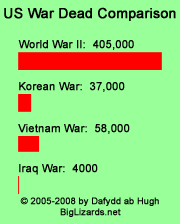March 10, 2006
Addendum to "Careful": Words Apart
Newsflash! The Associated Press is biased against Bush.
I know this shocks you, since we all believe that the elite media is non-partisan, unbiased, as pure as the driven dandruff. But now that RealClearPolitics finally has the AP-Ipsos poll up that we discussed in the previous post, and I finally got a chance to look at the actual numbers; and now that AP has a more complete story out about the poll, which includes a couple of minor little facts that didn't get mentioned in the earlier story that I linked last night... well, see for yourself.
The first point to note is my usual objection to such polling: this is a poll of national adults, a respondent pool that historically leans much further to the left than "registered voters," or even better, "likely voters." When asking about political questions -- and this entire poll is political in nature -- it only makes sense to restrict poll reporting to respondents who actually participate in the political process. Otherwise, it's like asking a teetotaller to rate the taste of different beers!
Also, as usual, Ipsos polled 6% more Democrats than Republicans (35 to 29); and of course, they did not weight for party affiliation. (When Independents were pushed to declare which way they leaned, the total rose from 35-29 to 51-39; but that might actually be picking up current attitude, rather than actual party affiliation, and they are right not to weight for that disparity.)
The very first sentence of the earlier story is a blatant falsehood, according to AP-Ipsos' own polling. It claims:
More and more people, particularly Republicans, disapprove of President Bush's performance, question his character and no longer consider him a strong leader against terrorism, according to an AP-Ipsos poll documenting one of the bleakest points of his presidency.
But it fails to mention that Bush's job approval now is exactly the same as it was in October and November of last year; and in fact, it's within the margin of error of every single poll Ipsos has taken in the last six months (except for December, when it bumped up very slightly). The same is also true for the right track/wrong track numbers, for Bush's handling of the economy, of foreign policy and terrorism, and of Iraq, each of which has been more or less the same for the past six to twelve months.
Respondents' opinion of Bush's likeability, honesty, and strength actually improved over the last poll, taken in November. Their opinion of his intelligence dropped, but their opinion of whether he is "arrogant" remained unchanged.
Thus, it is impossible to honestly portray this poll as showing any sort of trend away from Bush; more than anything else, it shows that people's opinion of him has barely budged in the last six months or longer.
But there is one more point which makes very clear the biased reporting about the poll (not the poll itself, which, despite its shortcomings, seems honest). Here is the smoking gun:
In the earlier story, written by AP Political Writer Ron Fournier, this is what AP had to say about the prospects for Iraq:
Nearly four out of five Americans, including 70 percent of Republicans, believe civil war will break out in Iraq - the bloody hot spot upon which Bush has staked his presidency.
But in the newer story, written by Will Lester with "contribution" by Fournier and AP Manager of News Surveys Trevor Tompson, one additional poll result is added; this result is not even mentioned in the first story by Fournier:
People are evenly divided on the prospects for a stable, democratic government in Iraq, with the number expecting a stable outcome about the same as a year ago, the poll found.
Sound a bit contradictory? All is explained by actually looking at the poll itself, which you can find here.
On the Iraq question, the sample was actually split in half: one half was asked "How likely is it that civil war will break out in Iraq?" This sample responded as reported in the earlier story (and the current), with 77% saying "likely."
How likely is it that civil war will break out in Iraq?
Likely: 77%
Unlikely: 17%
But the other half of the sample was asked a different question, one which did not suggest the negative answer:
How likely is it that a stable, democratic government will be established in Iraq?
Likely: 48%
Unlikely: 49%
What a difference the wording makes! As I've said before, the exact wording of a poll has a tremendous impact on the results you get. In fact, this result has held remarkably steady since at least April of 2004, when the numbers were 50% saying stable democracy was likely and 49% saying it was unlikely.
I believe that the new, sensationalist question was asked simply to produce a shocking response, which then became the headline of the second story. ("Somewhat likely" was one of the allowed responses, and it was lumped with "likely" for reporting. 39% said it was "very likely," 39% said it was "somewhat likely.")
The result that half the people expect a stable democracy in Iraq is snuck into the Lester story towards the very bottom, where it's unlikely to be seen by the great majority of readers.
In other words, as I noted in the previous post, this is a "media push" to try to turn people against the president, even though the underlying poll is not a push-poll. The problem isn't the poll itself; it's no more incompetent than 90% of the rest of the polling done by the Antique Media. The problem is the reporting on the poll, which is extraordinarily slanted.
But I think this might not have been such a surprise after all.
(In the extended entry below, I discuss two more demonstrably false claims in the new story, one about violence in Iraq, the other about American and British casualties.)
More bias is also evident in the second story, which repeats a pair of falsehoods to explain the president's supposed "drop" in the polls (despite the fact that he has not actually dropped).
Claim number one:
Violence in Iraq has escalated since the destruction of a 1,200-year-old shrine in Samarra in late February.
This is simply false, through and through. Violence did escalate right after the bombing; but then it subsided, and today, it's about where it was before the bombing. This sort of reporting especially leads people to imagine that Iraq is on the brink of civil war... the false idea that violence is getting worse and worse with no abatement.
Claim number two:
As the political situation in Iraq threatens to disintegrate, the toll of deaths and casualties for U.S. troops continues to mount.
There are only two possible ways to interpret this statement:
- Every month, the total number of casualties since March 2003 either goes up or stays the same; the total number of casualties never decreases.
- Every month, the number of casualties that month is higher than in most previous months.
Interpretation number one is simply ludicrous. Of course the number can only go up... unless we imagine that, as time passes, the dead rise and people get "unwounded" -- not healed but never wounded in the first place. So the only non-tautological interpretation is number two.
Which is an utter canard. The number of deaths and woundings per month is going down, not up. So either Mr. Lester is a fool, an ignoramus, or a liar; I suppose he can take his pick.
Shortly before the vote, starting in October, 2005, the number of U.S. and U.K. deaths rose sharply (as expected, with the terrorists trying to disrupt the vote). It jumped from a monthly average of 1.73 per day to 3.16 per day. Then in November, it dropped to 2.87, then to 2.19, then to 2.06 average per day. It "rose" to 2.07 in February, but that is simply an artifact of February having only 28 days: there were actually fewer deaths in February than January (58 and 64, respectively).
And this month, in ten days, there were only ten deaths -- a rate of 1.00 per day, less than half the rate of previous months. In fact, in 2005, there were a total of 874 American and British deaths in Iraq, or 2.46 per day. So far in 2006, in 69 days, there have been only 132 deaths -- for a daily rate of only 1.91. If that keeps up for the rest of the year, it will mean only 698 American and British deaths, for a drop of more than 20%.
If March is more typical than January and February -- the months immediately following the election and including the rise in violence following the bombing of the al-Askari Mosque (the "Golden Mosque") in Samarra, then we should see fewer than 400 deaths in Iraq in 2006... which would be less than half as many who died last year.
But wait! They said "the toll of deaths and casualties," not just deaths. Passing over the minor ignorance here -- "casualties" already includes both deaths and woundings -- maybe they're saying that the drop in deaths is more than made up for by a supposed rise in woundings.
Wrong again: woundings have also been dropping. (Note that we are now talking only about U.S. woundings; I can't find statistics about British woundings.)
In the 22 weeks from September 28th, 2005 through March 8th, 2006, there were 2,249 total woundings in action (102.2 per week). Breaking it down further, in the last 13 weeks of 2005 (through January 4th, 2006), there were 1,574 woundings, or 121.1 per week. In the first 9 weeks of 2006 (starting January 5th), there were only 675 woundings for 75.0 per week, a drop of 38% from the end of 2005 to now.
During this same 22-week period spanning the end of 2004 and the beginning of 2005, there were 3,753 woundings, which works out to 170.6 woundings per week -- compared to 102.2 recently. So in one year, the number of woundings dropped by more than 40%.
All right, sure -- maybe the total number of woundings is going down. But not all wounds are the same. Maybe AP means the severity of the woundings is increasing.
Nope; that too is going down. The military splits out woundings into two groups: those for which the soldier is returned to duty within 72 hours (minor wounds), and those for which he remains out of action for more than 72 hours (moderate to severe wounds). The percent of moderate to severe wounds in the 22-week period from 2004 to 2005 was 48%. The percent of moderate to severe wounds in the comparable period from 2005 to 2006 was only 39%. 61% of soldiers wounded were returned to duty within 72 hours.
None of this has been reported by the Antique Media. Instead, they continue to use phrases like "the toll of deaths and casualties for U.S. troops continues to mount." Is it any wonder that so many Americans think things are getting worse and worse, rather than better and better in Iraq?
Hatched by Dafydd on this day, March 10, 2006, at the time of 6:44 PM
Trackback Pings
TrackBack URL for this hissing: http://biglizards.net/mt3.36/earendiltrack.cgi/560
Comments
The following hissed in response by: RBMN
Well, if the participants accept the AP's definition of civil war, then a new "Iraqi civil war" probably starts and ends about every fourteen hours--every time something in Iraq goes boom!
The above hissed in response by: RBMN ![[TypeKey Profile Page]](http://biglizards.net/blog/nav-commenters.gif) at March 10, 2006 7:24 PM
at March 10, 2006 7:24 PM
The following hissed in response by: Bill Faith
I'm shocked, Dafydd. Shocked! I linked from Newsflash! The Associated Press is biased against Bush.
The above hissed in response by: Bill Faith ![[TypeKey Profile Page]](http://biglizards.net/blog/nav-commenters.gif) at March 10, 2006 8:16 PM
at March 10, 2006 8:16 PM
The following hissed in response by: Roy Lofquist
Polls have been horribly wrong from beginning (Dewey/Truman, 1948) to end (2004 exit polls). The only one that matters occurs on the first Tuesday after the first Monday in November. Paying attention to any other poll is sheer folly.
The above hissed in response by: Roy Lofquist ![[TypeKey Profile Page]](http://biglizards.net/blog/nav-commenters.gif) at March 11, 2006 6:45 PM
at March 11, 2006 6:45 PM
Post a comment
Thanks for hissing in, . Now you can slither in with a comment, o wise. (sign out)
(If you haven't hissed a comment here before, you may need to be approved by the site owner before your comment will appear. Until then, it won't appear on the entry. Hang loose; don't shed your skin!)© 2005-2009 by Dafydd ab Hugh - All Rights Reserved













